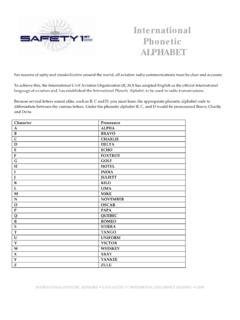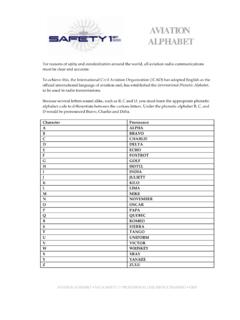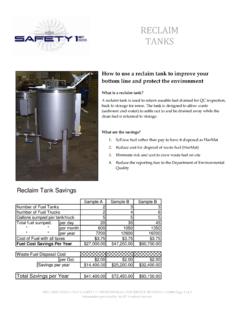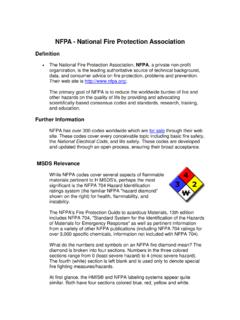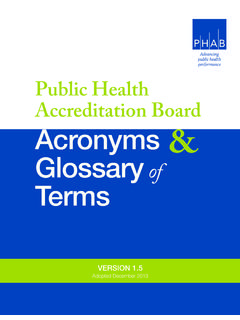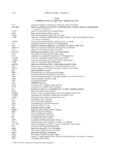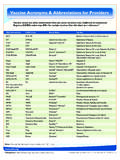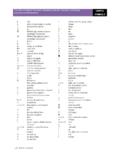Transcription of Aviation Terms and Acronyms - NATA Safety 1st PLST
1 Aviation Terms AND Acronyms NATA Safety 1ST PROFESSIONAL LINE SERVICE TRAINING 2007 Aviation Terms AND Acronyms A & P Mechanic: see Aircraft & Powerplant Mechanic Abeam: An aircraft is "abeam" a fix, point, or object when that fix, point, or object is approximately 90 degrees to the right or left of the aircraft track. Abeam indicates a general position rather than a precise point. ABO: See Aviators Breathing Oxygen Abort: To terminate a preplanned aircraft maneuver; , an aborted takeoff. Above Ground Fuel Storage Facility: A Fuel Storage Facility (system) whereby the fuel storage tanks are located above ground level. Above Ground Level: The height of an aircraft above ground level; also known as absolute altitude. May be determined by subtracting the elevation of the ground from the flight altitude above mean sea level. ACDO: See Air Carrier District Office "Acknowledge": Let me know that you have received and understood my message.
2 Acrobatic Flight: An intentional maneuver involving an abrupt change in an aircraft's altitude, an abnormal attitude, abnormal acceleration not necessary for normal flight. "Advise Intentions": Tell me what you plan to do. Advisory: Advice and information provided by a facility to assist pilots in the safe conduct of flight and aircraft movement. AD: see Airworthiness Directive. AD Oil: see Ashless Dispersant Oil . Advisory Frequency: The appropriate frequency to be used for airport advisory service. Advisory Service: Advice and information provided by a facility to assist pilots in the safe conduct of flight and aircraft movement. Aerial Refueling: A procedure used by the military to transfer fuel from one aircraft to another during flight. Aeronautical Chart: A map used in air navigation containing all or part of the following: Topographical features, hazards and obstructions, navigation aids, navigation routes, designated airspace, and airports.
3 Commonly used aeronautical charts are: 1. Sectional Charts: Designed for visual navigation of slow or medium speed aircraft. 2. VFR Terminal Area Charts: Depict Class B airspace which provides for control or segregation of all the aircraft within the Class B airspace. 3. World Aeronautical Charts (WAC): Provide a standard series of aeronautical charts covering land areas of the world at a size and scale convenient for navigation by moderate speed aircraft. 4. En Route Low Altitude Charts: Provide aeronautical information for en route instrument navigation (IFR) in the low altitude stratum. 5. En Route High Altitude Charts: Provide aeronautical information for En route instrument navigation (IFR) in the high altitude stratum. AFD: see Airport Facility Directory "Affirmative": Yes. Aft: Toward the rear of the aircraft. AGL: see Above Ground Level. Aileron: A primary flight control surface mounted on the trailing edge of the airplane wing, near the tip.
4 Air Brake: Any device primarily used to increase the drag of an aircraft. Air Carrier District Office: An FAA field office serving an assigned geographical area, staffed with Flight Standard s personnel serving the Aviation industry and the general public on matters related to the certification and operation of scheduled air carrier and other large aircraft operations. Air Carrier Operations: Arrivals and depart u res of air carriers certificated in accordance with FAR Part 121 and 127. Aircraft & Powerplant Mechanic: An Aviation mechanic who is licensed by the FAA and holds combined ratings of Airframe (A) and Powerplant (P). The A&P Mechanic services, repairs, and overhauls aircraft and aircraft engines to insure airworthiness. Aviation Terms AND Acronyms NATA Safety 1ST PROFESSIONAL LINE SERVICE TRAINING 2007 Air Route Traffic Control Center: A facility established to provide air traffic control service to aircraft operating on an IFR flight plan within controlled airspace and principally during the en route phase of flight.
5 When equipment capabilities and controller workload permit, certain advisory services may be provided to VFR aircraft. Air Taxi Operator: An air carrier certificated in accordance with FAR Part 135 and authorized to provide, on demand, public transportation of persons and property by aircraft. Generally operates small aircraft "for hire" for specific trips. Air Traffic: Aircraft operating in the air or on an airport surface, exclusive of loading ramps and parking areas. Air Traffic Control: A service operated by appropriate authority to promote the safe, orderly and expeditious flow of air traffic. Aircraft: A machine that can derive support from the atmosphere from the reaction of the air other than the reaction of the air against the earth's surface. Aircraft Classes: For the purposes of Wake Turbulence Separation Minima, ATC classifies aircraft as Heavy, Large, and Small as follows: (1) Heavy - Aircraft capable of takeoff weights of 300,00 pounds (136,078 kg) or more whether or not they are operating at this weight during a particular phase of flight.
6 (2) Large - Aircraft of more than 12,500 pounds (5,670 kg), maximum certificated takeoff weight, up to 300,00 (136,078 kg) pounds. (3) Small - Aircraft of 12,500 pounds (5,670 kg) or less maximum certificated takeoff weight. Aircraft Dispatch: The control and management of aircraft operations including; aircraft scheduling, weight and balance computation, route of flight planning, and weather data gathering. Aircraft Operations: The airborne movement of aircraft in controlled or uncontrolled airport terminal areas, and counts at en route fixes or other points where aircraft movements can be counted. There are two types of operations: local and itinerant. (1) LOCAL OPERATIONS are performed by aircraft that: (a) operate in the local traffic pattern or within sight of the airport; (b) are known to be departing for or arriving from flights in local practice areas located within a 20-mile radius of the airport; execute simulated instrument approaches or low passes at the airport.
7 (2) ITINERANT OPERATIONS are all aircraft operations other than local operations. Aircraft Rescue and Fire Fighting: Airport Fire Fighters specializing in aircraft fire and rescue techniques. Airfoil: Any surface, such as an aircraft wing or helicopter Rotor, designed to obtain a useful reaction, such as lift, from air passing over it. Airframe: The structure of an aircraft that does not include the powerplant. This would include the wings, fuselage, and tail Airman's Meteorological Information: In-flight weather advisories issued only to amend the area forecast concerning weather phenomena which are of operational interest to all aircraft and potentially hazardous to aircraft having limited capability because of lack of equipment, instrumentation, or pilot qualifications. Airmets cover moderate icing, moderate turbulence, sustained winds of 30 or more at the surface, widespread areas of ceilings less than 1,000 feet and\or visibility less than 3 miles, and extensive mountain obscurement.
8 AIRMET: see Airman's Meteorological Information Airplane: An engine driven fixed wing aircraft that is heavier than the air, and is supported in flight by the dynamic reaction of the air against its wings. Airport: An area on land or water that is used or intended to be used for the landing and takeoff of aircraft and includes its buildings and facilities, if any. Airport Advisory Service: A service provided by flight service stations at airports not served by a control tower. This service provides information to arriving and departing aircraft concerning wind direction/speed, favored runway, altimeter setting, pertinent known traffic/field conditions a, airport taxi routes, traffic patterns, and authorized instrument approach procedures. Airport Elevation: The highest point of an airport's usable runways measured in feet from mean sea level. Airport Facility Directory: A publication designed as a pilot's operational manual containing all airports, seaplane bases, and heliports open to the public including communications data, navigational facilities, and certain special notices and procedures.
9 Air Operations Area: The area used or intended to be used for the landing, takeoff, or surface maneuvering of aircraft. Airport Rotating Beacon: A visual navaid operated at many airports. At civil airport s, alternating white and green flashes indicate the location of the airport. At military airports, the beacons flash alternately white and green but a re diff e rentiated from civil beacons by dual-peaked (two quick) white flashes between the green flashes. Airport Surveillance Radar: Approach control radar used to detect and display an aircraft's position in the terminal area. ASR provides range and azimuth information but does not provide elevation data. Aviation Terms AND Acronyms NATA Safety 1ST PROFESSIONAL LINE SERVICE TRAINING 2007 Airport Traffic Control Tower: See Tower Airspeed: The speed of an aircraft relative to its surrounding air mass. The unqualified term "airspeed" means one of the following: 1. Indicated Airspeed The speed shown on the aircraft airspeed indicator.
10 This is the speed used in pilot/controller communications, it is referred to under the general term "airspeed." 2. True Airspeed - The airspeed of an aircraft relative to undisturbed air. Used primarily in flight planning and the en route portion of flight. When used in pilot/controller communications, it is referred to as "true airspeed" and not shortened to "airspeed." This is the "Indicated Airspeed" corrected for error due to air density (temperature and altitude). Airstart Unit (Ground): A mobile unit housing a turbine engine or other device used to generate high pressure air to rotate the turbine engine blades and start larger aircraft. Airworthiness Certificate: A certificate issued by the Federal Aviation Administration to aircraft which meet the minimum standards for airworthiness as specified in the appropriate part of the Federal Aviation Regulations. Airworthiness Directive: During the life of an aircraft, the manufacturer will sometimes find defects in the aircraft that make it unsafe for flight.
